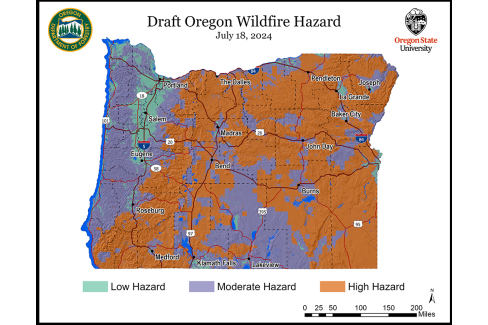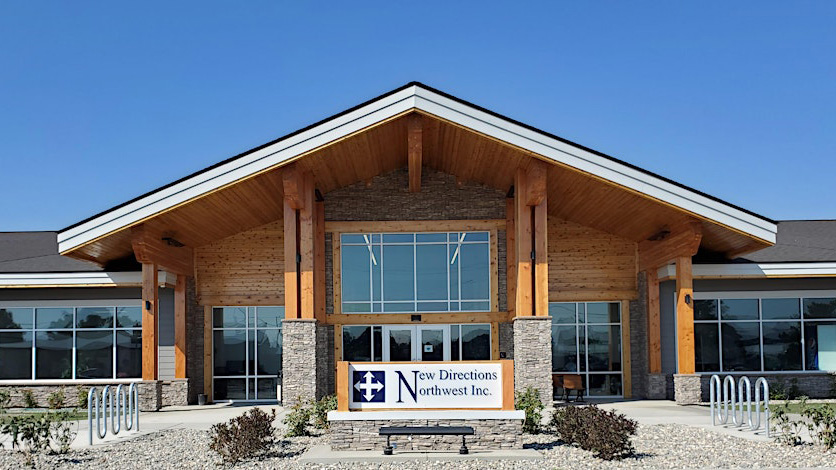
Jul 24, 2024 | Natural Resources
The Oregon Department of Forestry (ODF) released the most recent wildfire hazard map draft on July 18, inviting public review and comment until Aug. 18. Senate Bill 80 (2023) allows counties one additional opportunity to review the map, engage in further discussions, and consider making additional edits if desired. View official draft maps at Wildfire Risk Explorer.
SB 80 Section 1(13)(b) states: county commissioners, upon request by the county commissioners, must have one additional opportunity, arranged and scheduled by the Association of Oregon Counties, with either in-person attendance or a hybrid of in-person and remote attendance, to discuss concerns about the map and potential changes to the map.
County commissioners should notify AOC Staff if they would like to attend this additional opportunity. The meeting will occur in August at the Association of Oregon Counties (AOC) office in Salem. This meeting for counties is separate and distinct from the public comment period. Commissioners are welcome to attend in person or virtually for this discussion. ODF and Oregon State University (OSU) will present the draft map and gather this last round of feedback.
When AOC worked on the wildfire map section of SB 80 with ODF, counties were able to place in statute a series of meetings between counties and the state to ensure local characteristics, which were not factored into the SB 762 version, were considered.
SB 80 states in Section 1 (12): “… to ensure that local characteristics in each area of this state are considered in the mapping process and before the draft map is released, the department shall meet with County Commissioners and the county commissioners’ staff in eight in-person meetings throughout this state.”
Per SB 80 (2023) Section 1(12), in the fall of 2023, AOC hosted eight in-person and one virtual wildfire hazard map meetings in partnership with ODF throughout the state.
ODF and OSU used the gathered information from those meetings to begin implementing the feedback based on the four statutorily permissible criteria: vegetation, topography, weather, and climate. After making changes, ODF and OSU worked with county planning departments around the state to factor in additional local characteristics to the map.
The final version and official publication of the wildfire hazard map is projected to occur in October.
Contributed by: Branden Pursinger | Legislative Affairs Manager

Map courtesy of the Oregon State University College of Forestry and the Oregon Department of Forestry.

Jul 24, 2024 | AOC News
The Association of Oregon Counties (AOC) has hired Brandy Bradshaw as the Office Administrator.
Bradshaw joins AOC with a background in office management, including customer service, accounting, and project coordination. Previously, she managed all aspects of office operations for a local concrete company. “Brandy will be a wonderful addition to the AOC team and we are thrilled to have her on board to provide administrative support for the organization,” said AOC Executive Director Gina Nikkel.
Bradshaw’s first day was July 24.
Contributed by: Erin Good | Communications Coordinator

Jul 24, 2024 | County News, Health & Human Services
Baker County is one of several Oregon counties planning on developing a Law Enforcement Assisted Diversion (LEAD®) model deflection program in response to the new drug related misdemeanor that takes effect on Sept. 1. The Oregon Criminal Justice Commission allocated $150,000 to support Baker County as they develop a deflection program from the ground up.
The Association of Oregon Counties (AOC) was successful in advocating for maximum flexibility in how a local deflection program is administered and operated, allowing the required local partners to make the best use of their existing resources and processes. Baker County is collaborating with the Baker County Sheriff’s Office, the Baker City Police Department, Baker County Circuit Court, the Baker County District Attorney’s Office, and a local treatment provider to develop their deflection program, which will be run out of the sheriff’s office.
Baker County Chair Shane Alderson said the program will be up and running by September. “When the state legislature asked for counties to opt in early, I wanted to show support for the amendments to HB 4002, and I knew I had the right people,” Alderson said.
Baker County will use the services of a local treatment provider, New Directions Northwest (NDN), to offer substance use disorder assessments and referrals for individuals referred to the deflection program. As a Behavioral Health Resource Network provider, NDN offers recovery focused peer support programs, behavioral health screenings, and low barrier substance use disorder treatment.
According to NDN Training, Recruitment, and Special Projects Coordinator Claudia Wilcox, “the number of new certified alcohol and drug counselors in Eastern Oregon counties has decreased over the last several years while service needs have increased.”
In response, NDN recently launched the Eastern Oregon Behavioral Health Training Center to increase access to behavioral health services throughout Eastern Oregon by training individuals to become qualified behavioral health providers. The training center is currently on track to become the Eastern Oregon training hub for Oregon Health Authority (OHA) certified peer support specialists in adult addictions as well as certified alcohol and drug counselors.
Obtaining behavioral health provider training usually takes two years, with multi day courses often held in more populated areas. For rural Eastern Oregon residents, travel to these trainings involves significant time and added costs for lodging, per diem, and fuel, making it more expensive than for metropolitan counterparts. Limited budgets and workforce availability in Eastern Oregon further restrict attendance.
To address these financial barriers, the Greater Oregon Behavioral Health (GOBHI) awarded grants to the training center to provide stipends for travel, lodging, per diem, and childcare, as well as tuition scholarships. The training center’s central location in Eastern Oregon allows most individuals to commute on the same day as the training.
By the end of 2024 the training center’s goal is to see 30 new Certified Recovery Mentors and 36 new Certified Alcohol and Drug Counselors in the Eastern Oregon region. Courses are being taught onsite at the NDN Outpatient Facility in Baker County. In March, NDN purchased the former Blue Mountain Community College building in Baker City for use as a future home for the training center. The facility is currently being remodeled and will open soon.
Alderson says the county has hired a program coordinator, and is currently working on training for law enforcement and behavioral health providers, operational procedures, and a tracking system. “We have an outstanding team,” he said, “and I’m very proud of how everyone has stepped up.”
Contributed by: Erin Good | Communications Coordinator
This is the third article in AOC’s series on counties setting up deflection programs. Read previous articles:

Jul 23, 2024 | AOC Business Partner
Sponsored content contributed by AOC Business Partner: Regence
Be sure to stay hydrated and keep kids hydrated. Never leave kids or pets in the car on a hot day, even for a short time. Check up on the older people in your life every couple of days during a heat wave to ensure they are staying cool and hydrated.
What is heat exhaustion?
Heat exhaustion occurs when you are exposed to high temperatures, particularly when combined with high humidity. Signs and symptoms can develop suddenly or over time, especially with prolonged periods of exercise. Heat exhaustion symptoms include:
- Moist skin with goosebumps when in the heat
- Heavy sweating
- Dizziness
- Fatigue
- Weak, rapid pulse
- Muscle cramps
- Headache
- Fainting (passing out)
If you experience symptoms of heat exhaustion, stop all activity and rest. Find a cool place for your body to cool down and drink cool water. Heat exhaustion, if left untreated, can progress to heat stroke.
What is heat stroke?
Heat stroke occurs when your body overheats, usually due to extended exposure to or physical effort in hot temperatures. Heat stroke can happen when the body’s temperature rises rapidly and the body is unable to cool down with sweating. Heat stroke symptoms include:
- Altered mental state or behavior, such as confusion and slurred speech
- High body temperature (103°F or higher)
- Hot, red, dry or damp skin
- Nausea and vomiting
- Rapid breathing
- Racing heart rate
- Headache
- Dizziness
- Losing consciousness (passing out)
If you or someone you know starts experiencing symptoms of heat stroke, seek medical attention immediately.
How to stay safe in the heat
While heat exhaustion and heat stroke are serious conditions, they are also preventable. Keep these tips in mind to stay safe in hot weather:
- Avoid exercising outside during the hottest part of the day, typically between 11 a.m. and 3 p.m. Instead, plan your outdoor activities in the early morning hours or late evening to avoid unnecessary heat exposure.
- Drink plenty of water. The average adult needs 3 to 4 liters of water each day — that’s 12 8-oz glasses. During periods of excessive heat, plan to drink more than that as your body dehydrates more rapidly.
- Limit alcohol intake. Alcohol can affect the body’s ability to regulate its temperature.
- Wear loose-fitting, lightweight clothing. Heavy or tight clothing can prevent sweat from evaporating easily, so the body won’t cool down.
- Take steps to keep your home cool. This can include keeping your windows and doors closed during the day to prevent the heat from coming in. Try to avoid using the oven when you’re cooking. If you don’t have air conditioning, you can still keep cool with a fan to circulate the air.
- Use sunscreen and other protective measures to avoid sunburn.

Jul 22, 2024 | AOC Business Partner
Sponsored content contributed by AOC Business Partner: iSector
The Oregon iSector and Regional Rural Revitalization Strategies Consortium (R3) are working together to provide direct technical assistance and connection for rural communities statewide to address their local housing needs.
All jurisdictions have unique challenges, and strategies to produce housing differ. Identifying specific challenges city by city is critical to providing necessary assistance. Currently, there is no comprehensive inventory of the barriers that rural jurisdictions face in producing needed housing for their citizens. As the state develops funding and policy that addresses housing barriers, it is important that rural jurisdictions have a way to communicate their needs to ensure that state plans support those unique needs.
The Oregon iSector has developed a short questionnaire, the Community Housing Readiness Assessment, aimed at gathering insights into specific housing production opportunities and challenges for rural communities. Results from the assessment will be used by the iSector and R3 team to develop strategies to support housing production, and to deploy strategies for technical assistance including access to financing, zoning, public facilities, development, and other expertise.
Additionally, a dashboard of submitted sites has been created and will be shared with developers, funders, and other parties who can help produce needed housing. The dashboard will be used to inform the iSector and R3’s direct technical assistance work, as well as serve as a list of community needs informing funding and policy development designed to produce housing in Oregon.
For questions or to learn more please contact rural@isector.org, or visit their website at iSector.org.






